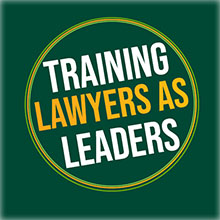
In our last post we encouraged our readers to make time for setting and evaluating goals and to help law students (and young lawyers) do the same. In this post we provide resources for use with the SMART technique (Specific, Measurable, Achievable, Realistic, Timely) for goal setting. We include the SMART technique in our textbook, Fundamental of Lawyer Leadership. In fact, we included it twice. We introduce students to the SMART goal-setting method in Chapter 9, Setting Goals, and we return to it in Chapter 20, How Leaders Manage Effectively, when discussing the importance of delegating and offering suggestions for how to delegate successfully.
Searching for goal setting advice offered to lawyers led to articles also recommending the SMART technique. I particularly liked Lawyer Personal and Career Goals because it starts with the question,
“’[W]hat’s your why?’ What kind of life do you want? … What impact do you want your work to have? Behind all those questions is your ‘why.’ It’s what gets you up in the morning and propels you through your day.”
The “why” should be the basis for setting goals and the control for evaluating actions.
Other recent articles written for lawyers:
Since the SMART technique is mentioned in all, I did some digging to learn more about its origin. Some sources suggest the renowned Peter Drucker should be credited with its creation based upon his 1954 book “The Practice of Management.” Drucker, credited as the father of modern business management, believed management involved creating systems to set objectives and evaluate performance as part of a wholistic approach to building effective and responsible organizations and institutions. Drucker, born in Austria and raised in Germany, earned a Ph.D. in International Law in 1932 and moved to America two years after some of his work was banned and burned by the Nazi. As with all of us, Drucker’s teachings were influenced by his life experiences. He believed “[m]anagement, practiced well,” was necessary not only for the successful functioning of a company but also as the “bulwark against evil” he witnessed in society. I think Drucker would approve of our efforts to equip law students to be ethical lawyers who own their obligation to be the guardians of democracy.
Works recognizing the benefits of adopting “specific and measurable” goals and objectives can be traced back to Drucker and others in the 1940s and 1950s. Particularly interesting to those of us at Baylor who knew Paul J. Meyer, a report on the History of SMART Objectives credits Meyer with use of the SMART acronym in his work “Personal Success Planner” in 1965. Meyer, a long-time resident of Waco and generous benefactor to Baylor University, was “a pioneer of the personal development industry.” Through his companies, Success Motivation Institute and Leadership Management Institute, Meyer’s programs were produced in more than 70 countries and 27 languages and influenced other renowned leadership authors (such as John C. Maxwell).
The first published article using the SMART acronym appears to have been written by George Doran, Arthur Miller, and James Cunningham for the November 1981 issue of Management Review, titled, “There’s a S.M.A.R.T. way to write management’s goals and objectives.” Written for business managers to assist with being more thoughtful about setting out a plan to accomplish an objective, they encourage these 5 considerations for each goal:
- Specific – target a specific area for improvement.
- Measurable – quantify or at least suggest an indicator of progress.
- Attainable – specify who will do it.
- Relevant – state what results can realistically be achieved, given available resources.
- Time-related – specify when the result(s) can be achieved.
We hope you will share with us the ways in which you incorporate the SMART technique into your work to better prepare law students and lawyers for leadership.
– LEAH




